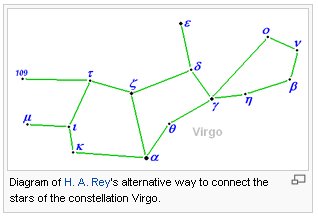The great and complicated glyph Cb1-6 should have some special relevance for us. At left is the 'earth' - the henua variant which I have named raaraa ('no Sun', central ceremonial ground) - and this is more strongly drawn than the somewhat weaker and shorter 'earth' at right. Autumn had arrived:
399 as glyph number for Cb1-7 minus 182 = RA number 217 (= 7 * 31). But should not this number rather refer to end of the previous day October 23? 399 ought to identify the end of the synodic cycle of Jupiter (Father Light) and when Arcturus in the night of April 21 (111 = 295 - 184) had exposed his bottom end close to the Full Moon it should be a bad Sign.
Arcturus 'carried' the key manzil fraction 0.4 we should remember:
The Syrma covered his ass:
... Syrma is from Σύρμα, used by Ptolemy to designate this star on the Train of the Virgin's robe. With κ and φ it was mentioned in the first Arabian translation of the Syntaxis as being in the h.imār, or 'skirt', of the garment; but the translator of the Latin edition of 1515, missing the point at the first letter, read the word as himār, 'an ass', so that this central one of these three stars strangely appears in that work as in asino. They formed the 13th manzil, Al Ghafr, the Covering, as Smyth explains, because the beauty of the earth is hidden, when they rise on the 18th Tishrīn, or 1st of November; others say on account of the shining of the stars being lessened as if covered; but Kazwini, because, when they rise, the earth robes herself in her splendour and finery, - her summer robes. The word, however, is analogous to Σύρμα, and so may have been taken from Ptolemy; although Al Bīrūnī quoted from Al Zajjāj Al Ghafar, the Tuft in the Lion's tail, which it may have marked in the figure of the ancient Asad. Another signification of the word Ghafr is the 'Young Ibex'. [Here I just have to insert the 'chessplayers':]
Al Bīrūnī also said that the Arabs considered this the most fortunate of their lunar mansions, as lying between the evils of the Lion's teeth [conspiciously missing in the picture above] and claws on one side and the tail and venom of the Scorpion on the other, and quoted from a Rajaz poet: The best night forever lies between Al Zubāna and Al Asad; adding that the horoscope of the Prophet lay here, and that the date of the birth of Moses coincided with it. As a lunar station these stars were the Sogdian Sarwa and the Khorasmian Shushak, the Leader; the Persian Hucru, the Good Goer; and the Coptic Khambalia, [also the name of the star λ] Crooked-clawed, λ being substituted for φ; and it is said that they were the Akkadian Lu Lim the He Goat, Gazelle, or Stag, the original perhaps meaning 'King' and employed for δ. ι alone, according to Hommel, was the Death Star, Mulu Bat ... 295 (Arcturus) - 121 (Bharani) = 174 = 6 * 29. I have to quote the rest of what Allen had to say regarding Syrma: "ι, κ, and υ constituted the 13th sieu, Kang, a Man's Neck, κ being the determining star; while, with the preceding station, the united group was Sheu sing, as Edkins writes it, the Star of Old Age; and, with others near, it may have been included in the Tien Mun mentioned at the star η. 'In China it [η] was Tso Chih Fa, the Left-hand Maintainer of Law. It lies on the left side of the Virgin, and just to the westward is the point of the autumnal equinox which the Chinese knew as Yih Mun, Twan Mun, or Tien Mun, Heavens Gate. With ζ it almost exactly marks the line of the celestial equator.' μ, a 3.9-magnitude, was Al Achsasi's Rijl al Al ┴wwā', the Foot of the Barker. It has been included with δ Librae in the Akkadian lunar asterism Mulu Izi, a title also applied to ε; the Sogdian Fasarwa, and the Khorasmian Sara-frsariwa, both signifying the 'One next to the Leader' - i.e., to the lunar asterism ι, κ, and λ."
Clearly there should be drums sounding when someone has died, drums as opposed to a crowing cock (moa ohoa) at birth.
(Embalmed corpse, picture in Antony Alpers' The World of the Polynesians.) | |||||||||||||||||||||||||||||||||||||||||||||||||||||||||||||||||||||||||||||||||||||||||||||||||||||||||||||||||||||||||||||||||||||||||||||||||||||||||||||||||||||||||||











